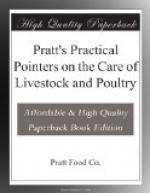Pratts Poultry Regulator should be added to the mash at the rate of one and three-quarters pound to each hundred pounds of mash. Mix thoroughly so each layer will get her share. The ideal poultry ration is a varied one. It contains mineral matter, green food, animal food and grains. The absence of any one of these groups of foodstuffs means a reduced egg yield.
-------------------------------------------------------
---------- I am both selling and feeding Pratts Poultry Regulator, and make a specialty of high-bred Buff Orpingtons. Twelve cockerels, worth from $20 to $75 each, were all placed in healthy condition by use of Pratts Poultry Regulator and their quarters disinfected with Pratts Disinfectant.
W.H. TOPP, Westgate, Iowa. ------------------------------------------------------------
-----
The staple grain feeds are corn, oats, wheat, barley and buckwheat. The grain by-products, bran, middlings and gluten feed, to which may be added corn meal, ground oats and ground barley.
Animal food of some kind is an essential to growth and egg-production. Skim milk and butter milk, fish scrap made from oil-free fish, beef scrap, fresh cut green bone and good grades of digester tankage are all excellent. But use only feeds of this character which are of prime quality. Oily fish, poor beef scrap and mouldy green bone will surely cause trouble.
Fowls on range during the growing season will pick up all needed green food. In the winter one may feed cabbages, mangel wurtzels, beets, carrots, etc. Or, if fresh stuff is not available, heavy oats may be sprouted and fed when the sprouts are two or three inches long. Dried beet pulp, a dairy food made at beet sugar factories, is a convenient green food. It must be well soaked before feeding.
One saves much time, and not infrequently some money, by buying ready-mixed feeds, especially dry mash. In, making such purchases, be guided by quality rather than price. Adopt some brand made by a reputable concern and give it a fair trial. But do not hesitate to change if a better brand becomes available. Just try Pratts Milk Egg Mash.
-------------------------------------------------------
---------- Kingston, R.I.
I have used your Baby
Chick Food with the best success and would
gladly recommend it
to anyone wanting such food. I do not only use
it for baby chicks,
but for those 5-7 weeks’ of age.
C.E. BRETT, Rhode Island State College Dept. of Poultry Service._ ------------------------------------------------------------
-----
Feeding Dry Mash
The most simple and generally satisfactory feeding method is the dry mash system. Feed a certain amount of the scratch mixture—whole and cracked grains—each day and permit the fowls to complete the daily ration by eating dry mash—ground grains—at will. Keep mash before them in open hoppers and let them help themselves.




